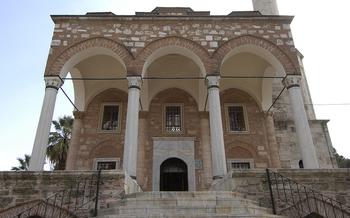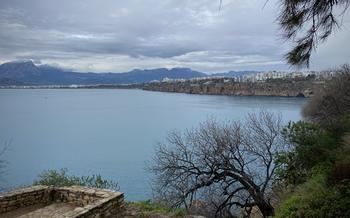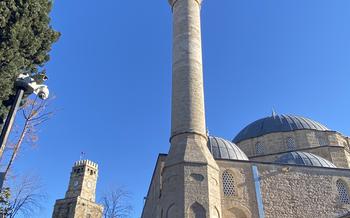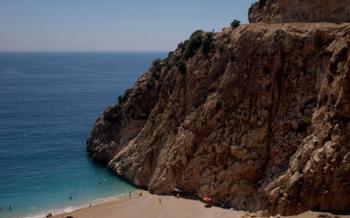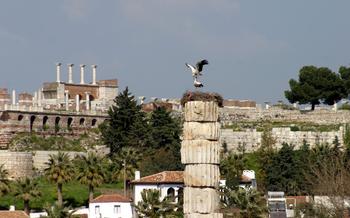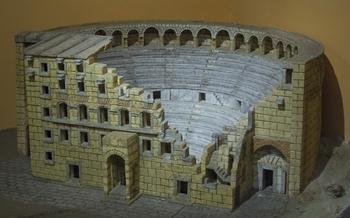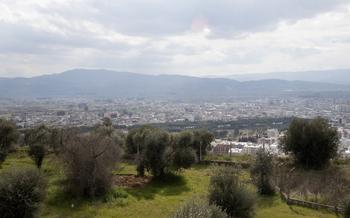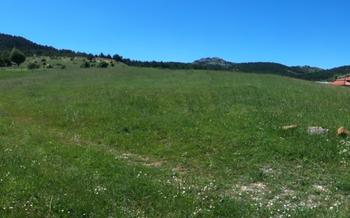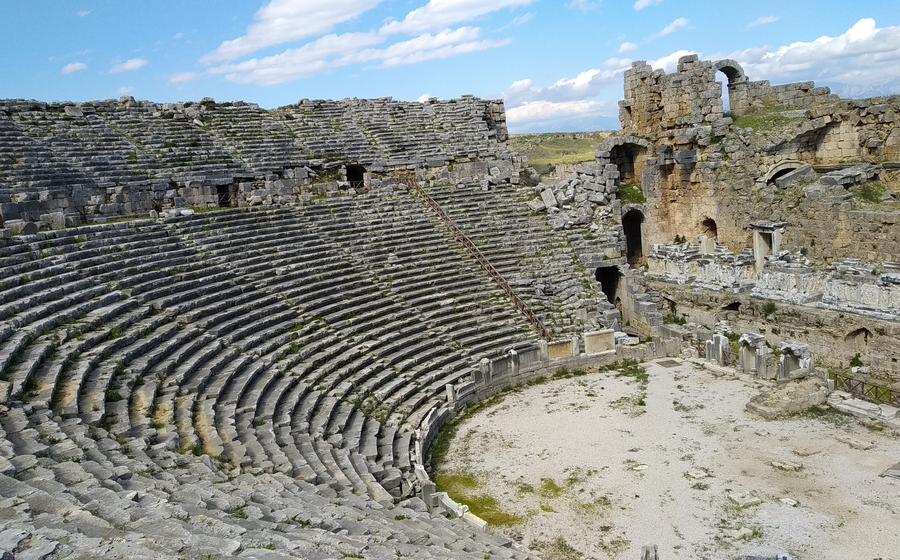
Perge Ancient City
- Exploring the Acropolis:
- The Colonnaded Street: A Grand Promenade through History
- The Roman Baths
- The Stadium: A Monument to Sports and Spectacle
- The Agora: The Heart of Perge's Commerce and Social Life
- The Theater: A Stage for Drama and Spectacle
- The Odeon: A Venue for Musical Delights
- The Byzantine Church: A Legacy of Early Christianity
- The Perge Museum: A Treasure Trove of Ancient Artifacts
- Tips for Photography Enthusiasts
- Insider Tip: Unraveling Perge's Secrets and Exploring Beyond
Exploring the Acropolis:
At the heart of Perge lies the Acropolis, the city's upper citadel. Ascend the ancient stone steps and enter a world of ruined temples, fortified walls, and panoramic vistas. The Acropolis served as the city's administrative and religious center, housing significant structures that offer a glimpse into Perge's glorious past.
Explore the remains of the Temple of Artemis, the city's patron goddess, and marvel at the intricate carvings that adorn its facade. Admire the well-preserved city gates and fortifications, which once protected Perge from invaders. Climb to the upper reaches of the Acropolis and be rewarded with breathtaking views of the surrounding countryside, stretching to the distant Taurus Mountains.
As you wander through the Acropolis, imagine the bustling streets and vibrant atmosphere of ancient Perge. Picture the city's elite gathering in the temples for religious ceremonies, or the sounds of battle echoing through the fortified walls. Delve into the rich history of this ancient city, and let your imagination transport you back to a time when Perge stood as a beacon of power and prosperity.
The Colonnaded Street: A Grand Promenade through History
In the heart of Perge, the magnificent Colonnaded Street stretches out as a testament to the city's grandeur. Flanked by towering columns, this impressive main road once served as a bustling hub of commerce and social life. The well-preserved columns, some still adorned with intricate carvings, create a picturesque scene that transports visitors back in time.
Along the colonnaded street, one can find a myriad of shops, fountains, and monuments, each holding its own story. Merchants displayed their wares, water flowed freely from the fountains, and statues of revered figures stood watch over the lively thoroughfare. Here, the city's inhabitants would gather, engage in trade, exchange ideas, and celebrate life.
The Colonnaded Street was not merely a practical passageway; it was a symbol of Perge's prosperity and cultural significance. Its grandeur reflected the city's status as a major trade center and a hub of learning and philosophy. Strolling along this ancient promenade, visitors can almost hear the echoes of laughter, the clamor of trade, and the footsteps of history.
Whether marveling at the architectural details, imagining the bustling atmosphere of bygone days, or simply soaking in the serene ambiance, the Colonnaded Street offers a captivating glimpse into the vibrant and sophisticated urban life of ancient Perge.
The Roman Baths
The Roman Baths in Perge are a testament to the city's opulence and the importance of bathing in Roman culture. The well-preserved complex features separate sections for hot, warm, and cold baths, allowing visitors to experience the ancient bathing rituals. Intricate mosaics and architectural details adorn the baths, providing glimpses into the artistry and craftsmanship of the Roman era. The significance of bathing extended beyond hygiene; it was a social activity, a place for relaxation and rejuvenation, and an essential part of Roman life. Exploring the Roman Baths offers a unique opportunity to immerse oneself in the daily routines and cultural practices of ancient Perge.
The Stadium: A Monument to Sports and Spectacle
In the heart of Perge, towering over the ancient city, stands the grand Stadium. This colossal structure, once the largest in the city, is a testament to the Romans' passion for sports and entertainment. With a seating capacity of over 12,000 spectators, the stadium was a place where the masses gathered to witness thrilling athletic competitions, gladiatorial battles, and other spectacles that defined the Roman way of life.
The stadium's imposing design reflects its importance in Perge's urban landscape. Its elliptical shape, reminiscent of Roman Colosseum, is defined by tiers of stone seating that rise steeply from the arena floor. Each tier is meticulously crafted with precision and symmetry, showcasing the Romans' architectural prowess.
Beyond its sporting significance, the stadium served as a multi-purpose venue for public events and ceremonies. It was a place where emperors and officials addressed the masses, where religious rituals were performed, and where the community came together to celebrate festivals and holidays. The stadium's versatility underscores its central role in the social and cultural fabric of ancient Perge.
Today, the stadium stands as a majestic ruin, its grandeur still palpable despite the passage of time. Visitors can wander through its ancient tiers, imagining the roar of the crowd as gladiators clashed in the arena below. The stadium's enduring presence serves as a reminder of the city's vibrant past and the enduring legacy of Roman culture.
The Agora: The Heart of Perge's Commerce and Social Life
The agora, or marketplace, was the central hub of Perge's economic and social activity. Located in the heart of the city, it was surrounded by shops, temples, and public buildings, creating a bustling and vibrant atmosphere. Here, merchants from across the region gathered to trade goods, farmers sold their produce, and citizens met to discuss the latest news and events.
In addition to its commercial importance, the agora served as a social gathering place for the community. It was here that people exchanged ideas, debated politics, and celebrated religious festivals. The agora was also the site of public meetings and announcements, making it a vital part of the city's political and administrative life.
The agora's central location and impressive architecture reflected its significance in Perge. It was surrounded by a colonnade, providing shelter from the sun and rain, and paved with marble slabs, ensuring a clean and orderly space. The buildings that lined the agora were adorned with intricate carvings and sculptures, adding to the overall grandeur of the area.
Today, the agora stands as a testament to Perge's former glory. Although many of the shops and temples have been reduced to ruins, the agora's layout and grandeur are still evident. Visitors can wander among the columns, imagining the hustle and bustle of ancient times, and admire the architectural details that have survived the centuries.
The Theater: A Stage for Drama and Spectacle
In the heart of Perge, nestled amidst the ancient ruins, the theater stands as a testament to the city's rich cultural heritage. With a seating capacity of over 10,000 spectators, it was once the epicenter of entertainment and artistic expression.
Constructed in the 2nd century AD, the theater boasts impressive architectural features that have withstood the ravages of time. The stage, adorned with intricate carvings and sculptures, served as a platform for theatrical performances, concerts, and public gatherings. The tiers of seating, rising in concentric semicircles, provided an unobstructed view of the stage from every angle.
The theater's acoustics are equally remarkable. The carefully designed arrangement of seats and the curved shape of the auditorium ensured that even the faintest whispers could be heard throughout the venue. This acoustic marvel allowed for a truly immersive experience, where actors and performers could captivate their audience with their voices and gestures.
Beyond its architectural and acoustic wonders, the theater holds significant historical and cultural importance. It was here that the people of Perge gathered to witness tragedies, comedies, and musical performances that reflected their shared values and beliefs. The theater was also a venue for public proclamations, political debates, and religious ceremonies, serving as a focal point for civic life.
Today, the theater stands as a silent witness to the vibrant cultural tapestry of ancient Perge. Visitors can wander through the tiers of seating, imagining the roar of the crowd as they cheered for their favorite performers. The theater, with its timeless beauty and historical significance, remains an enduring symbol of Perge's rich legacy.
The Odeon: A Venue for Musical Delights
Perge's Odeon, a smaller yet equally impressive theater, stands as a testament to the city's rich cultural life. With its intimate setting and exceptional acoustics, the Odeon was specifically designed for musical performances, recitals, and other artistic events.
In ancient times, music played a vital role in Greek and Roman culture, serving as a means of entertainment, education, and religious expression. The Odeon provided an ideal venue for musicians, singers, and poets to showcase their talents and connect with their audience on a deeper level.
Whether it was the melodious strains of a lyre, the rhythmic beats of a drum, or the enchanting voice of a singer, the Odeon's acoustics ensured that every note and nuance resonated throughout the theater, creating an immersive and captivating experience for all who attended.
Beyond its musical significance, the Odeon also served as a venue for recitals, poetry readings, and other cultural events. It was a place where intellectuals, artists, and members of the community could gather to share ideas, celebrate their heritage, and indulge in the finer aspects of life.
Today, the Odeon stands as a silent witness to the vibrant cultural scene that once flourished in Perge. Though its walls may be weathered and its stage empty, the spirit of music and artistic expression lingers within its ancient stones, inviting visitors to imagine the melodies and performances that once filled the air.
The Byzantine Church: A Legacy of Early Christianity
Amidst the ruins of Perge, stands a testament to the city's transition from paganism to Christianity - the Byzantine Church. Dating back to the 6th century, this church reveals the profound impact of early Christianity on the region. Its architectural features, intricate mosaics, and historical significance provide a glimpse into the transformation of Perge's religious and cultural landscape.
The Byzantine Church, with its cruciform plan, represents the shift from pagan temples to Christian basilicas. Its well-preserved apse, once adorned with vibrant mosaics, hints at the grandeur and devotion that characterized this sacred space. The remaining mosaics, depicting biblical scenes and figures, offer a glimpse into the artistic and theological expressions of the early Christian community in Perge.
This church serves as a poignant reminder of the profound changes that swept through the Roman Empire, as Christianity gradually took hold and transformed the religious beliefs and practices of its citizens. Perge's Byzantine Church stands as a symbol of this transition, inviting visitors to explore the rich tapestry of religious history that shaped this ancient city.
The Perge Museum: A Treasure Trove of Ancient Artifacts
The Perge Museum, located within the ancient city's walls, serves as a treasure trove of artifacts that unveil the rich history and culture of Perge. This on-site museum houses a diverse collection of sculptures, inscriptions, pottery, and other relics that have been meticulously excavated from the site.
As you wander through the museum's galleries, you'll encounter an array of captivating sculptures that depict gods, goddesses, emperors, and everyday people. These exquisite works of art offer a glimpse into the artistic prowess and cultural influences that shaped Perge's identity.
Among the museum's highlights are a series of intricate inscriptions that provide valuable insights into the city's history, laws, and religious practices. These inscriptions, etched onto stone tablets and fragments of pottery, offer a tangible connection to the thoughts and lives of Perge's ancient inhabitants.
The museum also boasts a remarkable collection of pottery, ranging from humble household wares to elaborately decorated vessels. These ceramic artifacts showcase the skill and creativity of Perge's potters and provide clues about the city's trading networks and culinary traditions.
A visit to the Perge Museum is an essential complement to exploring the ancient city itself. It offers an opportunity to delve deeper into the stories and significance of the ruins, enriching your understanding of Perge's past and its enduring legacy.
Tips for Photography Enthusiasts
Perge is a photographer's paradise, with its ancient ruins bathed in warm Mediterranean light. To capture the essence of this historical site, plan your visit for early morning or late afternoon, when the soft, golden light enhances the textures and colors of the ruins. Experiment with different angles and vantage points to create dynamic compositions. Climb to the acropolis for panoramic shots of the city and the surrounding countryside. Use a wide-angle lens to capture the grandeur of the colonnaded street and the stadium. Don't forget your tripod for long exposure shots that capture the ethereal quality of the ruins at night. With a bit of creativity and patience, you'll return home with a portfolio of stunning images that will transport you back to ancient Perge.
Insider Tip: Unraveling Perge's Secrets and Exploring Beyond
As you wander through the ancient ruins of Perge, keep an eye out for a hidden gem – a secret tunnel leading to the acropolis. This hidden passageway offers a unique perspective and a thrilling adventure for those seeking to explore beyond the beaten path.
Venture outside Perge to discover a wealth of other ancient sites and natural wonders. The region is dotted with ruins, including the ancient city of Aspendos with its remarkably preserved theater and aqueduct. Explore the scenic waterfalls of Manavgat or immerse yourself in the beauty of Köprülü Canyon National Park, where you can enjoy rafting, hiking, and breathtaking views.
To fully embrace the region's vibrant culture, time your visit to coincide with local festivals and events. The annual Perge Festival, held in July, showcases traditional Turkish music, dance, and crafts, providing an immersive experience of the region's rich heritage.
With its hidden treasures, surrounding attractions, and cultural events, Perge offers an unforgettable journey through history, nature, and local traditions. Embrace the insider tips to make your exploration even more rewarding and create lasting memories of your time in this ancient city.

